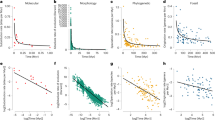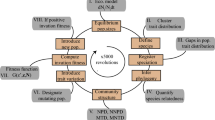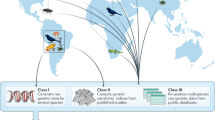Key Points
-
Co-evolutionary genetics of ecological communities offers a new understanding of adaptation and gene function that cannot be obtained from genomic data without an ecological context.
-
Some interspecific interactions, such as those that involve host and pathogen or predator and prey, can be intensified by reciprocal co-evolution, whereas other interactions, such as competition over limiting resources, can be diminished by reciprocal co-evolution.
-
Molecular phylogenetics offers an historical context for studying species interactions, providing evidence for co-speciation and the means for distinguishing co-speciation from other processes, like duplication or host switching.
-
Genotype-by-environment interactions (G x E) have a central role in co-evolution. They have given rise to many unique co-evolutionary adaptations, such as the inducible defenses of many prey species, which are textbook cases of adaptive phenotypic plasticity and developmental switching.
-
Under some circumstances, G x E increases genetic diversity in both species that interact with each other. This kind of interspecific G x E holds the potential to be an engine of biodiversity by accelerating co-evolution and facilitating the co-speciation of hosts and pathogens, whenever ecological communities are subdivided and gene flow among them is reduced.
-
The same genetic theory that was used to describe the evolution of epistatic interactions (interactions between nuclear genes at different loci) can be used to describe the co-evolution of interacting species. Recognizing that co-evolution affects gene combinations between species (that is, interspecific epistasis), epistasis theory can be applied to co-evolution in ecological communities. Just as reductions in recombination facilitate selection on gene combinations, co-dispersal of hosts and symbionts facilitates selection on interspecific gene combinations and leads to a high degree of interspecific cooperation, as in reciprocal obligate symbioses.
-
The co-evolution of mitochondrial–nuclear gene combinations is a model to study the co-evolution of interspecific gene combinations.
Abstract
Co-evolution has produced many intriguing adaptations and made significant contributions to biodiversity through the co-adaptive radiations of interacting groups, such as pollinating insects and flowering plants or hosts and endosymbionts. New methods from molecular genetics and comparative genomics, in conjunction with advances in evolutionary genetic theory, are for the first time providing tools for detecting, investigating and understanding the genetic bases of the co-adaptive process and co-speciation. Advances in the emerging field of community genetics, which integrates genetics and community ecology, could revolutionize how co-evolution is studied, how genes are functionally annotated and how conservation geneticists implement preservation strategies.
This is a preview of subscription content, access via your institution
Access options
Subscribe to this journal
Receive 12 print issues and online access
$189.00 per year
only $15.75 per issue
Buy this article
- Purchase on Springer Link
- Instant access to full article PDF
Prices may be subject to local taxes which are calculated during checkout




Similar content being viewed by others
References
Darwin, C. On the Origin of Species 95, 102 (Harvard Univ. Press, Cambridge, 1964).
Futuyma, D. J. & Slatkin M. (eds) Coevolution (Sinauer Associates, Sunderland, 1983). One of the earliest and most influential edited volumes on co-evolution, which clearly frames many important ecological genetic questions.
Thompson, J. N. The Geographic Mosaic of Coevolution (Univ. Chicago Press, Chicago, 2005). This book develops the leading evolutionary hypothesis of community ecology, that local co-adaptation is the fundamental unit of ecosystem function.
Clayton, D. H. & Moore J. (eds) Host–Parasite Evolution: General Principles & Avian Models (Oxford Univ. Press, Oxford, 1997).
Spaulding, A. E. & von Dohlen, C. D. Psyllid endosymbionts exhibit patterns of co-speciation with hosts and destabilizing substitutions in ribosomal RNA. Insect Mol. Biol. 10, 57–67 (2001).
Fuqua, C. & Winans, S. C. Conserved cis-acting promoter elements are required for density-dependent transcription of Agrobacterium tumefaciens conjugal transfer genes. J. Bacteriol. 178, 435–440 (1996).
Tollrian, R. & Harvell C. D. The Ecology and Evolution of Inducible Defenses (Princeton Univ. Press, Princeton, 1999).
Boeing, W. J., Wissel, B. & Ramcharan, C. W. Costs and benefits of Daphnia defense against Chaoborus in nature. Can. J. Fish. Aquat. Sci. 62, 1286–1294 (2005).
Lively, C. M. Predator-induced shell dimorphism in the acorn barnacle Chthamalus anisopoma. Evolution 40, 232–242 (1986).
Verschoor, A. M., van der Stap, I., Helmsing, N. R., Lurling, M. & Van Donk, E. Inducible colony formation within the Scenedesmaceae: adaptive responses to infochemicals from two different herbivore taxa. J. Phycol. 40, 808–814 (2004).
Van Donk, E., Lürling, M. & Lampert, W. in Ecology and Evolution of Inducible Defenses (eds Tollrian, R. & Harvell, C. D.) 89–103 (Princeton Univ. Press, Princeton, 1999).
Kyong, H., Jang, M.-H., Joo, G.-J. & Takamura, N. Growth and morphological changes in Scenedesmus dimorphus induced by substances releases from grazers, Daphnia magna and Moina macrocopa. Kor. J. Limnol. 34, 285–291 (2001).
Vos, M. et al. Inducible defenses and trophic structure. Ecology 85, 2783–2794 (2004).
Fisher, R. A. The Genetical Theory of Natural Selection 2nd edn (Dover Press, New York, 1958).
Lerner, I. M. Genetic Homeostasis (John Wiley & Sons, New York, 1954).
van Valen, L. A new evolutionary law. Evol. Theory 1, 1–30 (1973).
Webb, C. A complete classification of Darwinian extinction in ecological interactions. Am. Nat. 161, 181–205 (2003).
Hubbell, S. P. The Unified Neutral Theory of Biodiversity and Biogeography (Princeton Univ. Press, Princeton, 2001).
Whitham, T. G. et al. Community genetics: a consequence of the extended phenotype. Ecology 84, 559–573 (2003).
Whitham, T. G. et al. A framework for community and ecosystem genetics: from genes to ecosystems. Nature Rev. Genet. 7, 510–523 (2006).
Wade, M. J. Community genetics and species interactions. Ecology 84, 583–585 (2003).
Kiester, A. R., Lande, R. & Schemske, D. W. Models of coevolution and speciation in plants and their pollinators. Am. Nat. 124, 220–243 (1984). These authors established the principles that co-evolution takes place between traits and that the co-evolutionary effective population size is determined by the rarer species.
Brodie III, E. D. & Ridenhour, B. J. Reciprocal selection at the phenotypic interface of coevolution. Integr. Comp. Biol. 43, 408–418 (2003).
Ebert, D., Zschokke-Rohringer, C. D. & Carius, H.-J. Within- and between-population variation for resistance of Daphnia magna to the bacterial endoparasite, Pasteuria ramose. Proc. R. Soc. B Biol. Sci. 265, 2127–2134 (1998).
Agrawal, A. & Lively, C. M. Infection genetics: gene-for-gene versus matching alleles models and all points in between. Evol. Ecol. Res. 4, 79–90 (2002).
Via, S. & Lande, R. Genotype–environment interaction and the evolution of phenotypic plasticity. Evolution 39, 505–522 (1985).
Falconer, D. S. The problem of environment and selection. Am. Nat. 86, 293–298 (1952).
Stearns, S. C. The evolutionary significance of phenotypic plasticity. BioScience 39, 436–445 (1989).
Schlichting, C. D. & Pigliucci, M. Phenotypic Evolution: A Reaction Norm Perspective (Sinauer Associates, Sunderland, 1998).
Ahnesjo, J. & Forsman, A. Differential habitat selection by pygmy grasshopper color morphs; interactive effects of temperature and predator avoidance. Evol. Ecol. 20, 235–257 (2006).
Curtsinger, J. W., Service, P. M. & Prout, T. Antagonistic pleiotropy, reversal of dominance, and genetic polymorphism. Am. Nat. 144, 210–228 (1994).
Page, R. D. M. Tangled Trees: Phylogeny, Cospeciation, and Coevolution (Univ. of Chicago Press, Chicago, 2003). The most comprehensive and up-to-date reference on the issues of comparing phylogenies in co-evolutionary studies.
Jousselin, E., Rasplus, J.-Y. & Kjellberg, F. Convergence and coevolution in a mutualism: evidence from a molecular phylogeny of Ficus. Evolution 57, 1255–1269 (2003).
Herre, E. A. in Levels of Selection in Evolution (ed. Keller, L.) 209–237 (Princeton Univ. Press, Princeton, 1999).
Clark, M. A., Moran, N. A., Baumann, P. & Wernegreen, J. J. Cospeciation between bacterial endosymbionts (Buchnera) and a recent radiation of aphids (Uroleucon) and pitfalls of testing for phylogenetic congruence. Evolution 54, 517–525 (2000).
Page, R. D. M. & Charleston, M. A. Trees within trees: phylogeny and historical associations. Trends Ecol. Evol. 13, 356–359 (1998).
Whitlock, M. C., Phillips, P. C. & Wade, M. J. Gene interaction affects the additive genetic variance in subdivided populations with migration and extinction. Evolution 72, 1758–1769 (1993).
Brodie, E. D. Jr, Ridenhour, B. J. & Brodie III, E. D. The evolutionary response of predators to dangerous prey: hotspots and coldspots in the geographic mosaic of coevolution between garter snakes and newts. Evolution 56, 2067–2082 (2002).
Wade, M. J. in Epistasis and the Evolutionary Process (eds Wolf, J., Brodie III, E. D. & Wade, M. J.) 213–231 (Oxford Univ. Press, Oxford, 2000).
Wade, M. J. in Artificial Life VII Workshop Proceedings (eds Maley, C. C. & Boudreau, E.) 79–81 (MIT Press, Cambridge, 2000).
Cockerham, C. C. & Weir, B. S. Digenic descent measures for finite populations. Genet. Res. 30, 121–147 (1977).
Goodnight, C. J. On the effect of founder events on the epistatic genetic variance. Evolution 41, 80–91 (1987).
Goodnight, C. J. Epistasis and the effect of founder events on the additive genetic variance. Evolution 42, 441–454 (1988).
Wade, M. J. & Goodnight, C. J. Cyto-nuclear epistasis: two-locus random genetic drift in hermaphroditic and dioecious species. Evolution 60, 643–659 (2006).
Wade, M. J. in Key Words in Evolutionary Biology (eds Keller, E. F. & Lloyd, E. A.) 87–91 (Harvard Univ. Press, Cambridge, 1992).
Wade, M. J., Winther, R. G., Agrawal, A. F. & Goodnight, C. J. Alternative definitions of epistasis: dependence and interaction. Trends Ecol. Evol. 16, 498–504 (2001).
Phillips, P. C., Otto, S. P. & Whitlock, M. C. in Epistasis and the Evolutionary Process (eds Wolf, J. B., Brodie, E. D. & Wade, M. J.) 20–38 (Oxford Univ. Press, Oxford, 2000).
Priest, N. K., Roach, D. A. and Galloway, L. F. Mating-induced recombination in fruit flies. Evolution 61, 160–167 (2007).
Weir, B. S. Genetic Data Analysis II (Sinauer Associates, Sunderland, 1996).
Cruzan, M. B. & Arnold, M. L. Consequences of cyto-nuclear epistasis and assortative mating for the genetic structure of hybrid populations. Heredity 82, 36–45 (1999).
Wolf, J. B., Brodie III, E. D. & Wade, M. J. in Phenotypic Plasticity. Functional and Conceptual Approaches (eds DeWitt, T. & Scheiner, S.) (Oxford Univ. Press, Oxford, 2002).
Blachford, A. & Agrawal, A. F. Assortative mating for fitness and the evolution of recombination. Evolution 60, 1337–1343 (2006).
Lapolla, J. S., Schultz, T. R., Kjer, K. M. & Bischoff, J. F. Phylogenetic position of the ant genus Acropyga Roger (Hymenoptera: Formicidae) and the evolution of trophophoresy. Insect Syst. Evol. 37, 197–212 (2006).
Braendle, C. et al. Developmental origin and evolution of bacteriocytes in the aphid — Buchnera symbiosis. PLoS Biol. 1, e21 (2003).
Lynch, M. & Gabriel W. Mutation load and the survival of small populations. Evolution 44, 1725–1737 (1990).
Charlesworth, D., Morgan, M. T. & Charlesworth, B. Mutation accumulation in finite outbreeding and inbreeding populations. Genet. Res. 61, 39–56 (1993).
Paine, T. D., Raffa, K. F. & Harrington, T. C. Interactions among scolytid bark beetles, their associated fungi, and live host conifers. Annu. Rev. Entomol. 42, 179–206 (1997).
Wilson, D. S. & Knollenberg W. G. Adaptive indirect effects: the fitness of burying beetles with and without their phoretic mites. Evol. Ecol. 1, 139–159, (2005).
Bergstrom, C. T. et al. in Genetic and Cultural Evolution of Cooperation (ed. Hammerstein, P.) 241–256 (MIT Press, Cambridge, 2003).
Brandvain, Y., Barker, M. S. & Wade M. J. Gene co-inheritance and transfer. Science (in the press).
Neuhauser, C. et al. Community genetics: expanding the synthesis of ecology and genetics. Ecology 84, 545–558 (2003).
Clay, K. Hereditary symbiosis in the grass genus, Danthonia. New Phytol. 126, 223–231 (1994).
Clayton, D. H., Bush, S. E., Goates, B. M. & Johnson, K. P. Host defense reinforces host–parasite cospeciation Proc. Natl Acad. Sci. USA 100, 15694–15699 (2003).
Hessen, D. O. & Van Donk, E. Morphological changes in Scenedesmus induced by substances released from Daphnia. Arch. Hydrobiol. 127, 129–140 (1993).
Spaulding, A. W. & von Dohlen, C. D. Psyllid endosymbionts exhibit patterns of co-speciation with hosts and destabilizing substitutions in ribosomal RNA. Insect Mol. Biol. 10, 57–67 (2001).
Acknowledgements
I thank N. Priest, D. McCauley, J. Bever, Y. Brandvain, J. D. Van Dyken, T. Cruickshank, D. Drury, J. Thompson and D. Huestis for comments on the manuscript, and the US National Institutes of Health and the US National Science Foundation for support of this research.
Author information
Authors and Affiliations
Ethics declarations
Competing interests
The author declares no competing financial interests.
Related links
Glossary
- Geographic mosaic
-
A theory of community ecology that was founded on the premise that communities are genetically and ecologically subdivided so that the rate of co-evolution varies geographically, resulting in rapid co-evolution (hot spots) in some localities but slower co-evolution (cold spots) in others.
- Congeners
-
Species that are members of the same genus.
- Quorum sensing
-
Gene expression patterns in bacteria that are conditional on colony density.
- Inducible defence
-
An adaptive phenotypic change in a prey species that develops in response to predation on conspecifics, which reduces vulnerability.
- Trophic structure
-
The species interactions that make up food chains and energy flows through an ecological community.
- Co-evolutionary arms race
-
The escalating and reciprocal co-evolution between the offensive ability of a predator and the defensive capability of its prey.
- Life-history trade-off
-
A negative correlation between viability and the amount or timing of reproduction, such that an increase in one results in a concomitant decrease in the other.
- Character displacement
-
Phenotypic differences between sympatric species that arise as an evolutionary response to competition for shared, limiting resources.
- Red Queen hypothesis
-
The continual evolutionary change by a species that is necessary to retain its place in an ecosystem because of ongoing co-evolution by other species.
- Darwinian extinction
-
A decline in mean fitness that occurs as a result of adaptation by natural selection, which reduces the size of the population until it becomes inviable.
- Gene-for-gene model
-
A model of host–pathogen co-evolution that proposes that, for every gene in the host that confers resistance, there is a corresponding virulence gene in the pathogen.
- Genotype-matching model
-
An ecological genetic model of host–pathogen co-evolution that proposes that rare host genotypes escape the more abundant pathogens, which are adapted to more common host genotypes, leading to oscillations in population size and genetic composition of both species.
- Gene flow
-
The movement of genes from one population to another, as individuals leave their population of birth and become breeding members of another.
- Synteny
-
The conservation of gene order over chromosome segments across taxa.
- Random genetic drift
-
Random changes in allele frequency from one generation to the next.
- Trophophoresy
-
The transporting of a species that is used for food by another species.
Rights and permissions
About this article
Cite this article
Wade, M. The co-evolutionary genetics of ecological communities. Nat Rev Genet 8, 185–195 (2007). https://doi.org/10.1038/nrg2031
Published:
Issue Date:
DOI: https://doi.org/10.1038/nrg2031
This article is cited by
-
The microbiome extends host evolutionary potential
Nature Communications (2021)
-
The importance of genomic variation for biodiversity, ecosystems and people
Nature Reviews Genetics (2021)
-
Host–parasite co-evolution and its genomic signature
Nature Reviews Genetics (2020)
-
Criteria for Holobionts from Community Genetics
Biological Theory (2019)
-
A mapping framework of competition–cooperation QTLs that drive community dynamics
Nature Communications (2018)



